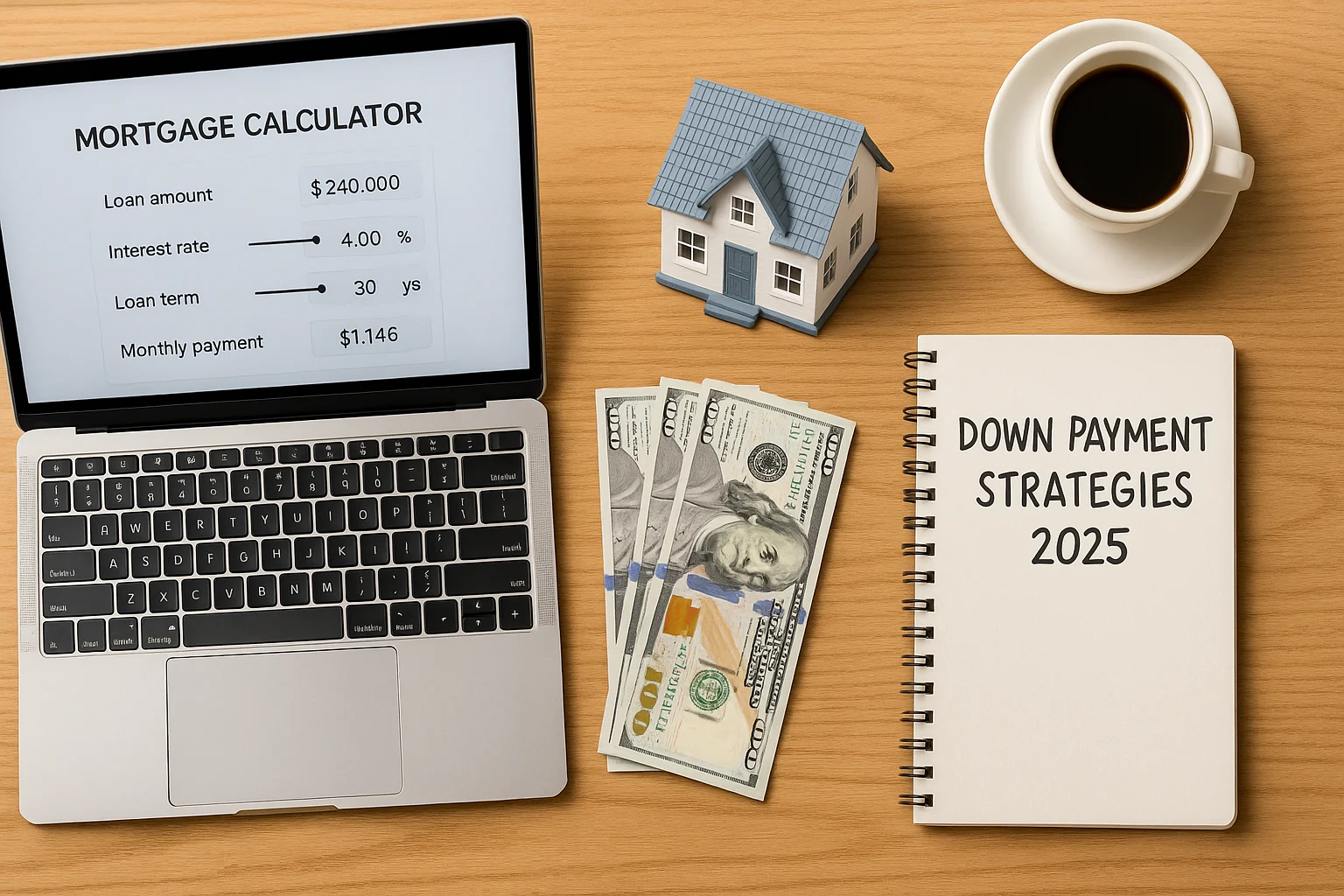
Struggling to finance your first rental in 2025’s tricky market? Imagine owning a cash-flowing property that funds your dream lifestyle – from a cozy Airbnb to a bustling apartment complex. With 2025 bringing tighter loan rules and new opportunities, securing investment property loans requires a sharp strategy. Unlike buying a home to live in, financing a rental property involves higher stakes, stricter criteria, and unique loan options. Fortunately, this comprehensive guide breaks down everything you need – from loan types and approval tips to down payment hacks and 2025 trends – to help you confidently unlock your real estate investment dreams.
Find Your Perfect Loan!Table of Contents
- Why Investment Property Loans Differ in 2025
- Types of Investment Property Loans: Your Perfect Fit
- Loan Type Comparison Table
- Approval Criteria for Investment Property Loans
- Down Payment Strategies
- Interest Rates and Costs for Investment Property Loans
- Special Considerations for 2025 Property Types
- Loan Application Process
- Common Pitfalls to Avoid
- Which Loan Type Suits You? Quick Quiz
- Frequently Asked Questions
- Your Path to Rental Property Financing Success
Why Investment Property Loans Differ in 2025
When you buy a home to live in, lenders see low risk – you need a roof over your head! However, investment property loans are riskier for lenders since the property isn’t your primary residence, and rental income isn’t guaranteed. As a result, they come with stricter rules and unique products. In 2025, trends like AI-driven underwriting and a boom in short-term rentals shape the landscape. Here’s what’s new:
- Tech-Driven Approvals: Lenders use advanced data tools to assess property potential, speeding up approvals for qualified investors.
- Short-Term Rental Boom: More lenders offer loans that consider Airbnb or VRBO income, not just personal income.
- Mixed-Use Growth: Urban demand fuels financing for properties blending residential and commercial spaces.
- Rate Volatility: With rates projected at 6.5-7.5% for conventional loans, cash flow planning is critical.
“Investment property loans aren’t just about your wallet – they’re about the property’s ability to pay its own way.”
How They Differ from Home Mortgages
Unlike a typical mortgage, here’s what sets investment loans apart:
- Higher Down Payments: Expect 15-30%, compared to 3% or less for primary homes.
- Stricter Credit: A 700+ FICO is often required, versus 620 for home loans.
- Higher Rates: Rates are 0.5-1% above owner-occupied loans due to risk.
- Income Focus: Lenders analyze the property’s rental income potential, often using Debt Service Coverage Ratio (DSCR).
- Cash Reserves: You’ll need 3-6 months of mortgage payments saved post-closing.
By understanding these differences, you’re better equipped to navigate the 2025 financing landscape.

Types of Investment Property Loans: Your Perfect Fit
Choosing the right loan for your rental property is crucial for cash flow and ROI. Thankfully, 2025 offers diverse options tailored to various strategies. Here’s a breakdown:
1. Conventional Loans
Backed by Fannie Mae or Freddie Mac, these are ideal for 1-4 unit residential properties.
- Pros: Competitive rates, predictable terms, fixed or adjustable options.
- Cons: 15-25% down for single units, 25-30% for 2-4 units; 700+ FICO; strict DTI.
- Best For: Long-term rentals, investors with strong finances.
2. DSCR Loans: Income-Focused Financing
Debt Service Coverage Ratio (DSCR) loans prioritize the property’s income over your personal finances, perfect for short-term rentals. For new hosts, Airbnb loan options for new hosts can make all the difference.
- How They Work: Lenders divide the property’s Net Operating Income (NOI) by its debt (principal, interest, taxes, insurance). A DSCR of 1.25+ is ideal.
- Example: If monthly NOI is $3,000 and debt is $2,000, DSCR = 1.5.
- Pros: Less focus on personal income, great for Airbnb, faster approvals.
- Cons: Higher rates, 20-25% down, property must generate strong income.
- Best For: Short-term rental investors, self-employed borrowers.
Case Study: Sarah’s Airbnb Success – Sarah, a part-time host, used a DSCR loan to buy a $400,000 cabin. With AirDNA projecting $4,000 monthly income and $1,200 in expenses, her NOI of $2,800 gave a DSCR of 1.4, securing approval despite her high personal DTI. Explore fast funding for short-term rentals to see how you can replicate her success.
3. Hard Money Loans
These short-term, asset-based loans are ideal for fix-and-flips. Check out this guide on short-term property loans for flippers for quick funding tips.
- How They Work: Lenders focus on the property’s after-repair value (ARV).
- Pros: Fast closings (days), lenient credit, good for distressed properties.
- Cons: High rates (8-15%), high fees, short terms (6-24 months).
- Best For: Flippers needing quick funding.
“Hard money loans are a sprint, not a marathon – perfect when speed is everything.”
4. Private Money Loans
Loans from individuals offer flexibility but rely on relationships.
- Pros: Custom terms, fast closings, less strict criteria.
- Cons: Hard to find lenders, potential relationship strain.
- Best For: Investors with strong networks.
5. Commercial Loans
Best for 5+ unit properties or mixed-use spaces.
- Pros: High loan amounts, property-focused underwriting.
- Cons: Complex applications, 25-40% down, balloon payments.
- Best For: Large multi-family or mixed-use investors.
6. Portfolio Loans
Offered by lenders who keep loans in-house, these are flexible.
- Pros: Lenient criteria, good for unique situations.
- Cons: Higher rates, fewer lenders.
- Best For: Non-traditional borrowers or properties.
7. HELOCs/Cash-Out Refinance
Use home equity to fund down payments.
- Pros: Lower rates, access to capital without selling.
- Cons: Puts your home at risk, adds debt.
- Best For: Homeowners with significant equity.
8. Owner-Occupied vs. Non-Owner Occupied
Owner-occupied loans have better terms but require you to live in the property. Misrepresenting intent is fraud.
9. Government-Backed Loans (FHA/VA)
FHA and VA loans are typically for primary residences, but FHA may work for 1-4 unit properties if you live in one unit. However, strict rules limit their use for investment property loans. Consult a lender to explore eligibility.
- Pros: Lower down payments (3.5% for FHA), competitive rates.
- Cons: Occupancy requirements, limited to specific scenarios.
- Best For: Investors planning to live in a multi-family property.
Loan Type Comparison Table
| Loan Type | Down Payment | Interest Rate | Best For |
|---|---|---|---|
| Conventional | 15-30% | 6.5-7.5% | Long-term rentals |
| DSCR | 20-25% | 7-8.5% | Short-term rentals |
| Hard Money | 25-35% | 8-15% | Fix-and-flips |
| Commercial | 25-40% | 6.5-8% | Multi-family, mixed-use |
| FHA (Owner-Occupied) | 3.5-10% | 6-7% | Multi-family with residency |
Approval Criteria for Investment Property Loans
Lenders assess risk carefully. Here’s what they scrutinize in 2025:
1. Credit Score
Aim for 700+, ideally 740+, for the best rates. Improve by paying bills on time, reducing credit card balances (below 30%), and avoiding new credit.
2. Down Payment
Plan for 15-30%. Save aggressively, use home equity, or partner up to meet requirements.
3. Debt-to-Income (DTI) Ratio
Keep DTI below 43%. Pay down debts or boost income to improve.
Example: $2,000 monthly debts ÷ $6,000 income = 33% DTI.
4. Cash Reserves
Have 3-6 months of PITI saved. Cut discretionary spending to build reserves.
5. Property Analysis
Lenders evaluate rental income, vacancy rates, expenses, and location. Provide a detailed pro forma and market research.
6. Investor Experience
Not always required, but prior landlord success helps. Start small or partner with pros.
Down Payment Strategies
Since down payments are a major hurdle, try these:
- Savings: Create a dedicated account, cut expenses.
- Home Equity: Use a HELOC or cash-out refinance. Caution: Your home is at risk.
- Partnerships: Pool funds with a partner, backed by a legal agreement.
- Seller Financing: Rare, but negotiate with sellers for flexible terms.
- Self-Directed IRA: Use retirement funds, but consult a custodian.
Case Study: Mike’s Equity Play – Mike used a $100,000 HELOC from his primary home to fund a 25% down payment on a $400,000 duplex, securing a conventional loan with 7% interest. For unique properties, mixed-use mortgage approval hacks can help you navigate complex financing needs.

Interest Rates and Costs for Investment Property Loans
Rates for investment property loans are higher due to risk. In 2025, expect 6.5-7.5% for conventional, 7-8.5% for DSCR, per NAR.
Rate Factors
Credit score, LTV, loan type, and market conditions drive rates. Fixed-rate loans offer stability; ARMs start lower but risk increases.
Closing Costs
Budget 2-5% of the loan for fees like origination, appraisal, and title insurance. Review the Loan Estimate carefully.
Special Considerations for 2025 Property Types
Short-Term Rentals
DSCR loans shine here, using AirDNA projections. However, regulations (e.g., NYC’s Local Law 18) and high expenses require due diligence. Learn how to avoid risks with short-term rental loans to stay ahead of lender pitfalls.
Mixed-Use Properties
Commercial or SBA loans are ideal for mixed-use properties blending residential and commercial spaces. For tailored strategies, check out financing live/work spaces to navigate 2025’s unique challenges.
These properties often require creative financing to maximize ROI. Explore creative mixed-use financing strategies for practical solutions that work.
Choosing the right lender is key, from local banks to nationwide options. Learn more about mixed-use property loan options to find the best fit.
Green Financing for Energy-Efficient Rentals
In 2025, eco-friendly rentals attract tenants and lenders offering green loans with favorable terms. These loans reward energy-efficient upgrades, reducing costs. Check with lenders for programs supporting sustainable investments.
Fix-and-Flips
Hard money or bridge loans are ideal. Have a clear exit strategy and renovation budget.
Multi-Family (5+ Units)
Commercial or agency loans focus on NOI and occupancy. Strong management plans are key.
Loan Application Process
Follow these steps for a smooth process:
- Prepare Finances: Check credit, gather documents.
- Get Pre-Approved: Verify income and assets for a commitment letter.
- Shop Lenders: Compare Loan Estimates.
- Find Property: Work with an agent, do due diligence.
- Apply & Underwrite: Submit documents, get an appraisal.
- Clear Conditions: Address lender requests.
- Close: Review Closing Disclosure, sign, and get keys.
Common Pitfalls to Avoid
Avoid these traps:
- Underestimating Costs: Budget for all expenses plus a buffer.
- Not Shopping Lenders: Compare multiple offers.
- Skipping Due Diligence: Verify income and regulations.
- Misrepresenting Finances: Be honest to avoid fraud.
- Low Reserves: Save 3-6 months of PITI.
Which Loan Type Suits You? Quick Quiz
Find the best loan for your 2025 investment goals with this quick quiz. Click through the questions to see your personalized recommendation!
What’s your investment goal?
Frequently Asked Questions
Your Path to Rental Property Financing Success
Real estate investing in 2025 is full of potential, but securing the right financing is your foundation. By mastering rental property financing, from conventional to DSCR, you can build wealth through rentals, flips, or mixed-use properties. Use tools like our quiz, stay informed on trends like AI underwriting, and always do your due diligence. With these strategies, your 2025 investment goals are within reach – start building your portfolio today!
This content is for informational purposes only and does not constitute financial advice. Loan terms, rates, and approval criteria vary by lender and your financial situation. Consult a qualified financial advisor and mortgage professional before making investment decisions.